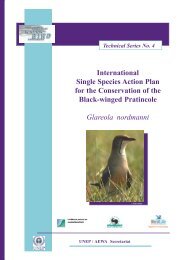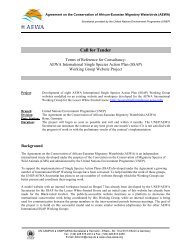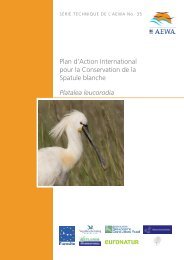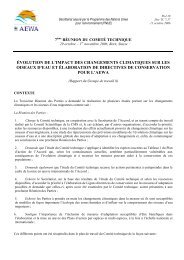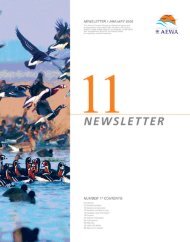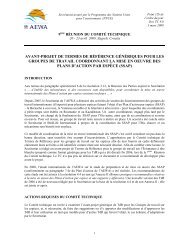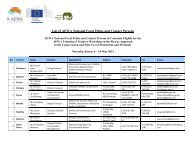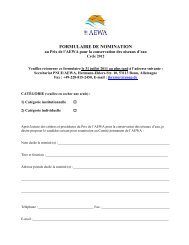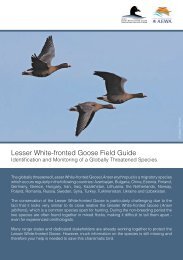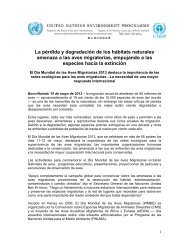International Single Species Action Plan for the ... - AEWA
International Single Species Action Plan for the ... - AEWA
International Single Species Action Plan for the ... - AEWA
You also want an ePaper? Increase the reach of your titles
YUMPU automatically turns print PDFs into web optimized ePapers that Google loves.
<strong>AEWA</strong> Technical Series No. 36<br />
Islamic Republic of NO YES (?) YES<br />
Iran<br />
Iraq NO YES (?) YES<br />
Kazakhstan NO YES NO<br />
Russian Federation YES YES NO<br />
Syria NO YES (?) YES<br />
Turkey NO YES YES (?)<br />
Turkmenistan NO YES (?) YES (?)<br />
Ukraine NO YES YES<br />
Uzbekistan NO YES YES<br />
(?) = uncertain and/or significant shortage of in<strong>for</strong>mation<br />
1.5 Survival and Productivity, Life Cycle and Habitat Requirements<br />
The following is a brief summary of <strong>the</strong> key points influencing <strong>the</strong> <strong>Action</strong> <strong>Plan</strong>.<br />
Survival and productivity<br />
Ra<strong>the</strong>r good productivity and survival data are available <strong>for</strong> <strong>the</strong> Fennoscandian population<br />
and an elasticity analysis has been per<strong>for</strong>med (Lampila 2001, Markkola & Lampila 2003), but<br />
patchy count data and <strong>the</strong> low number of ringing recoveries means that evidence <strong>for</strong> <strong>the</strong><br />
Western main population is essentially anecdotal. Lampila (2001) demonstrated that low<br />
survival was <strong>the</strong> key factor determining <strong>the</strong> negative population development <strong>for</strong><br />
Fennoscandian Lesser White-fronts.<br />
Fur<strong>the</strong>r research has shown that <strong>the</strong> productivity of <strong>the</strong> Fennoscandian population has less<br />
annual variation than it is <strong>the</strong> case <strong>for</strong> o<strong>the</strong>r arctic geese (this may be because <strong>the</strong> species<br />
breeds fur<strong>the</strong>r south than o<strong>the</strong>r arctic geese species). Survival of 1st calendar year (1cy) and<br />
2nd calendar year (2-cy) birds is relatively poor. Modelling work indicates that increases in<br />
both adult and 1-cy/2-cy survival are required in order <strong>for</strong> <strong>the</strong> current population decline to be<br />
arrested and reversed. A very small increase in adult survival can have a greater impact on <strong>the</strong><br />
overall population level than an apparently more significant increase in juvenile/immature<br />
survival. (J. Markkola, P. Lampila pers. comm; Markkola and Lampila 2003) 4 . Hunting<br />
pressure is considered <strong>the</strong> main cause of adult mortality.<br />
In future productivity of Lesser White-fronted Geese could be assessed by counting <strong>the</strong><br />
proportion of juvenile birds in autumn staging flocks at Porsanger Fjord, Norway<br />
(Fennoscandian population) and north-west Kazakhstan (Western main population).<br />
However, this requires a long-term, intensive and consistent ef<strong>for</strong>t. Calculating survival rates<br />
is more challenging still, since counts are required both in spring and in autumn. Such biannual<br />
counts are already done <strong>for</strong> <strong>the</strong> small Fennoscandian population, but would be a major<br />
undertaking <strong>for</strong> <strong>the</strong> Western main population.<br />
More research is needed to compare <strong>the</strong> survival and productivity of <strong>the</strong><br />
supplemented/reintroduced and wild populations.<br />
Life cycle<br />
Because Lesser White-fronted Geese are long-distance migrants, international cooperation is<br />
a prerequisite <strong>for</strong> effective conservation. Fur<strong>the</strong>rmore, as breeding occurs in <strong>the</strong> sub-arctic<br />
4<br />
A <strong>the</strong>oretic study using differently pre-defined age classes <strong>for</strong> demographic modelling currently assesses <strong>the</strong><br />
potential impact of juveniles and 1-2-cy survival on population growth rate (P. S. Gulve pers. comm.). A PVA<br />
analysis on <strong>the</strong> basis of time-series data from annual bird counts is also underway in 2008 (pers. comm. Aaravak).<br />
The relative implications of differential mortality of adult and young birds will be subject to fur<strong>the</strong>r examination,<br />
bearing in mind <strong>the</strong> central importance of reducing overall LWfG mortality.<br />
<strong>International</strong> <strong>Single</strong> <strong>Species</strong> <strong>Action</strong> <strong>Plan</strong> <strong>for</strong> <strong>the</strong> Conservation of <strong>the</strong> Lesser White-fronted Goose 19



